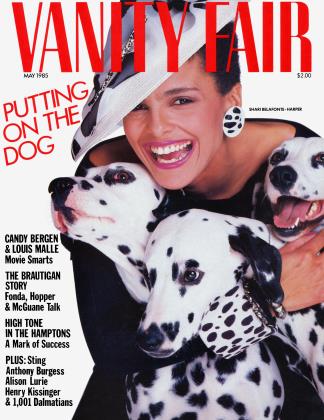Sign In to Your Account
Subscribers have complete access to the archive.
Sign In Not a Subscriber?Join NowVintage Kertész
PHOTOGRAPHY
Pepe Karmel
Last year, the Hungarian government invited photographer Andre Kertesz to return home for a celebration of his ninetieth birthday. "Hungary discovered ma carriere very late," he says. "But they made me a very nice celebration. It made me too, too, too high." Kertesz's early work (collected in the recent volume Hungarian Memories) captured a simple, Tolstoyan world of peasants, soldiers, wandering musicians, and impoverished Gypsies. On his recent visit he found a very different country from the one he'd left behind. "The Communists in Hungary are the biggest N bourgeois. So many people ⅛ have a car and a summer house. * Some people make more, some 1 people make less, but no com® plaints. Everybody has what he wants—even the Gypsies. I don't know how this happened."
From 1912 to 1925 Kertesz was a clerk at the Budapest Stock Exchange, photographing in his spare time. Like so many other East European artists and intellectuals, he could not resist the gravitational tug of Paris. There, he became a full-time photographer, his work appearing in numerous French, German, Italian, and English papers and magazines. Attentive to the momentary accidents and encounters of city life, he invented a quick, deceptively casual style that would later be adopted by "street" photographers from Cartier-Bresson to Garry Winogrand. In 1936, with the shadow of Hitler looming over Europe, Kertesz emigrated to New
York, only to find that his old-world reputation counted for little. Though he found steady work (largely with the Conde Nast magazines), it was not until the 1960s that he was rediscovered by the art world. In the 1970s, a series of brilliant books, such as On Reading, J'aime Paris: Photographs Since the Twenties, and Washington Square, finally brought him a wide American audience.
Kertesz's overhead views of streets, parks, and still lifes translate the lessons of cubism into the language of photography. But the most distinctive aspect of his work is its evocation of privacy in the midst of crowds, the bittersweet melancholy of the individual adrift in the modern city. His photographs are gentle violations of private lives. In an early Hungarian masterpiece, from 1915, he catches a pair of formally dressed lovers locked in a half-passionate, half-demure embrace on a park bench. In later pictures, from New York, he swoops down with a telephoto lens to discover readers taking their solitary pleasures on asphalt rooftops and city streets. What makes the intrusion tolerable is that the private reverie unveiled in Kertesz's pictures is always, one feels, his own. He is the lover, the reader, the dreamer rising above the grimy reality of modem life.
Kertesz's beloved wife of forty-four years, Elizabeth, died in 1977. Since then he has lived alone in their apartment overlooking Washington Square. At the age of ninety-one, he is still traveling and taking pictures. This month, the Chicago Art Institute and New York's International Center of Photography and Susan Harder Gallery will each offer retrospectives of his work. "They will," he says, "be 90 percent vintage material—what is not easy to find." Today, the dealers are paying enormous sums for his old prints. Not that Kertesz makes anything from such resales—but he seems pleased by the recognition it implies. He laughs. "The price is crazy." □
 View Full Issue
View Full Issue












Subscribers have complete access to the archive.
Sign In Not a Subscriber?Join Now